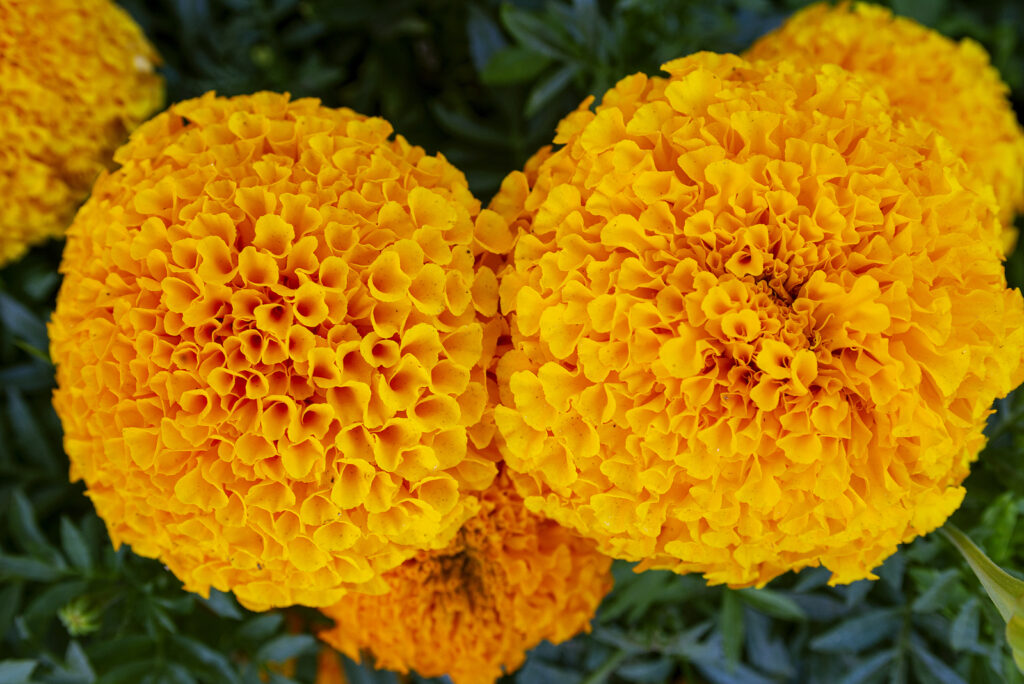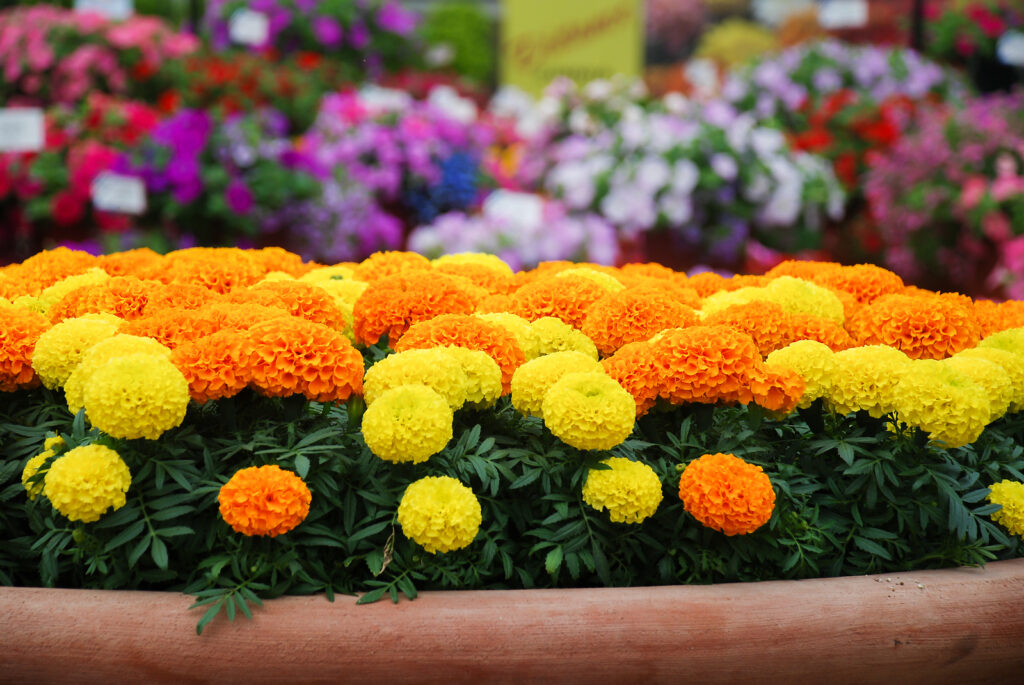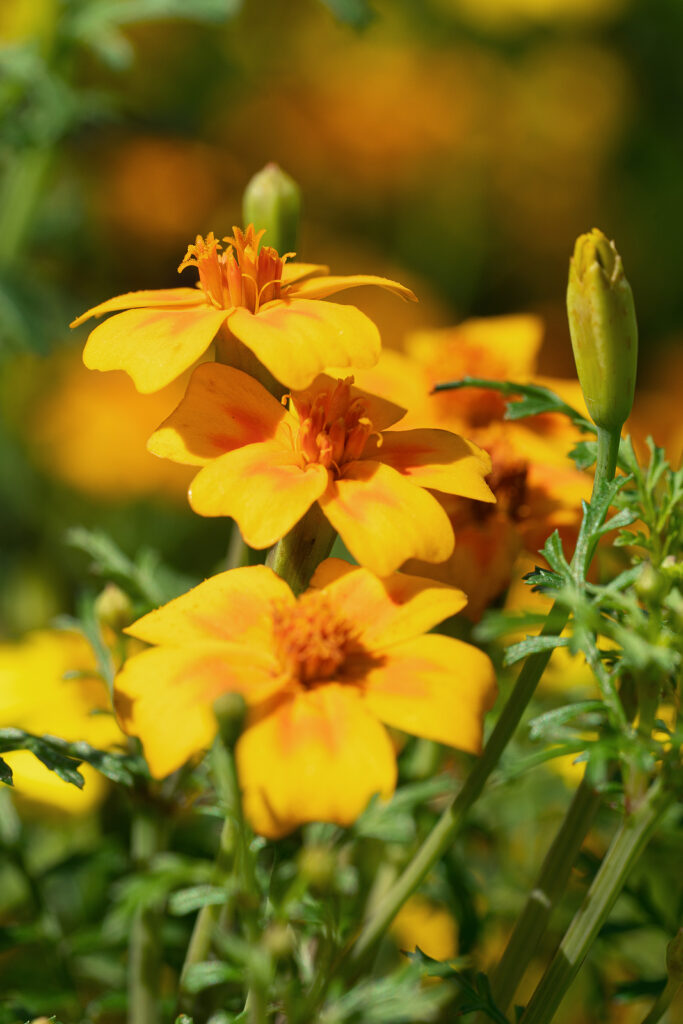Tagetes–commonly called marigolds–bear yellow, orange, red, or mahogany flowers from summer to early fall. The marigold is a tender annual.
African marigolds and French marigolds are commonly grown in summer gardens. African marigolds grow 2 to 4 feet (61-122cm) tall. French marigolds grow just 6 to 12 inches (15-30cm) tall.
Marigolds flowers can be simple and daisylike or full and camellia-like. Single and semi-double varieties will attract butterflies and other insects. The foliage is fine and ferny.
Marigolds can have a sharp odor; these can be used to repel pest insects in the garden. Some newer cultivars are odorless.
Flower Garden Success Products at Amazon:
- Wildflower Seed Mix Attracts Hummingbirds and Butterflies
- Eden Brothers All Perennial Seed Mix
- 10 pcs Stainless Steel Garden Hand Tool Set
- Gorilla Cart 4 Cu. Ft, 300-pound Capacity
- Neem Bliss 100-% Cold Pressed Neem Oil
- Safer Brand Insect Killing Soap

Get to know marigolds — Tagetes
- Plant type: Tender annual
- Growing Zones and range: All zones
- Hardiness: Tender; Thrives in heat, withstands cool weather above freezing
- Height and width: 6 to 48 inches (15-122cm) tall; 4 to 24 inches (10-61cm) wide, depending on the variety
- Foliage: Mid- to dark green almost fern-like leaves are usually opposite
- Flowers: Daisylike or camellia-like flowerheads 1 to 4 inches (2.5-10cm) across.
- Flower colors: Yellow, gold, orange, russet, deep red, cream
- Bloom time: Summer until frost
- Uses: Beds, borders, and containers
- Common name: African marigold, French marigold, Signet marigold
- Botanical name: Tagetes spp.
- Family: Asteraceae
- Origin: Dry slopes and valleys from New Mexico to Argentina; one species occurs in Africa
Where to plant marigolds — Tagetes
- Plant Tagetes in full sun in Zone 2-6; grow marigolds in sun or light shade in Zones 7-11
- Grow Tagetes in humus-rich to average soil that is well-drained.
- Tagetes prefer a soil pH of 6 to 8.
Marigolds — Tagetes uses
- Grow Tagetes marigolds in annual beds and borders.
- Tagetes can be used in foregrounds, bedding, edging, window, boxes, and other containers.
- Yellow-tinted Tagetes fit into any garden scheme.

When to plant marigolds — Tagetes
- Set Tagetes in the garden in spring after all danger of frost has passed.
- Start seeds indoors 4 to 6 weeks before the last expected frost. Germination usually takes five days.
- Sow seeds outdoors when they will grow a week after the last frost in spring or later.
- Set container-grown plants in the garden after all danger of frost has passed after hardening them off in the shade for a few days.

Planting and spacing marigolds — Tagetes
- Sow seeds in small pots or six-packs in moist potting soil; cover seeds with 1/8 inch of soil. Water and keep at 60° to 70°F (15.6°-21°C) until seeds germinate in about 5 days.
- Set seedlings in a bright spot or a few inches below fluorescent lights until seedlings have four to six leaves.
- Sow seeds outdoors in smoothly prepared beds; cover seeds with 1/8 inch soil.
- Thin outdoors-grown plants when they are 4 inches (10cm) tall.
- Set container-grown plants in the garden when all danger of frost is passed.
- Space Tagetes 4 inches to 18 inches (10-45cm) apart depending on the variety.

How to water and feed marigolds — Tagetes
- Tagetes need moderate water; keep the soil evenly moist.
- Fertilize Tagetes occasionally. Boost blossoms by applying low nitrogen, high phosphorus, and potassium fertilizer when plants are 5 to 6 inches (12.7-15cm) tall.
Marigolds — Tagetes care
- Mulch around Tagetes to conserve soil moisture.
- Trim off spent blooms to ensure long-blooming.
- Blooms slow when temperatures reach 90°F/32°C.
- Marigolds are susceptible to botrytis, root rot, fusarium wilt, rust, leaf spot, slugs, and Japanese beetles.
Marigolds — Tagetes pests and diseases
- Tagetes are prone to gray mold, bacterial leaf spot, powdery mildew, fungal leaf spot, damping off, and root rot.
- Leaf miners, spider mites, and whiteflies can attack Tagetes, especially in the greenhouse.
Good Products for Seed Starting Success at Amazon:
- Jump Start Germination Station w/Heat Mat Tray, 72-Cell Pack, Dome
- Espoma Seed Starting Mix
- 200 Count- Jiffy 7 Peat Soil Seed Starting Plugs
- Seed Starter Kit with Humidity Dome (120 Cells Total Tray)
- AgrobriteT5 Fluorescent, 2-Foot, Grow Light System
Marigolds — Tagetes propagation
- Sow seed in the garden in late spring, earlier if the soil is warm.
- Seeds are large and should be planted 1/4 inch deep.
- Seeds germinate in about 7 days at 75° to 80°F (24°-27°C).

Marigolds — Tagetes varieties to grow
- African marigold (Tagetes erecta) is also called Mexican marigold; it is not from Africa; it is from Central America; this marigold can grow to 2 to 4 feet (1.2m) tall; flowers are 4 inches (10cm) or more across. African marigolds are used for bedding and borders; camelia-shaped varieties are available. ‘Inca’ and ‘Perfection’ are cultivars widely available.
- Irish lace marigold (Tagetes filifolia) bear numerous small flowers above lacy foliage; the flowers are often considered less showy than the leaves.
- Tagetes lemmonii grows in arid, desert regions; it is covered in small golden flowers.
- French marigolds (Tagetes patula) low-growing cultivars 6 to 12 inches (15-30cm) tall; there are many vivid colors, and some are banded or splotches with contrasting reds or gold; these are the most pest-resistant.
- Signet marigolds or Mexican marigolds (Tagetes tenuifolia): this plant bears 1-inch (2.5cm), single or double flowers in a full range of colors; plants form mounds about 6 inches (15cm) tall; the foliage is feathery and threadlike.
- Triploid marigold: Triploid marigolds (T. patula x erecta).are a cross between the African and French. These are low to medium-growing plants. They grow well in very hot summer regions.
Marigolds — Tagetes frequently asked questions
Q: What are French marigolds and African marigolds?
A: African marigolds (Tagetes erecta) are tall plants with double flowers including carnation-flowered, chrysanthemum-flowered, dahlia-flowered, and peony-flowered. Use these tall marigolds at the back of a bed or border. French marigolds (T. patula) can have single, crested, anemone, carnation, or double flowers. Use these smaller plants at the front of a border. A third type of marigold is known as triploid and is a cross between the African and French (T. patula x erecta). These are low to medium-growing plants.
Q: I’ve read that triploid marigold (T. patula x erecta) is the best. Is that true?
A: Triploid marigolds are low to medium-growing plants that bloom all summer even in the hottest regions. They do not set seeds so the dead flowers drop cleaning from the plant. The best-known triploid at the Nugget series includes Red Seven Star and orange and yellow Mighty Marietta.
Q: Can marigold seeds be planted directly in the garden?
A: Seeds of French marigolds can be sown directly in the garden. They will germinate quickly. Seeds of African and triploid marigolds must be started indoors 4 to 8 weeks before the last frost in spring.
Q: What causes marigolds to not blossom?
A: There are a number of reasons marigolds may not bloom: too late sowing seed, too much rain, soil too heavy or too rich, pests and disease attacks, insufficient sun, overfeeding, overwatering, and failure to remove faded flowers.
Q: What is the benefit of planting marigolds in the vegetable garden?
A: Marigolds repel certain beetles and nematodes that attack some vegetables.
Related Articles:
- 20 Perennials That Bloom for 6 to 8 Weeks
- Shrubs with Showy Flowers Season-by-Season
- Trees in Garden Design
- Growing Annuals for Summer Bloom
- Trees—click here for more articles
- Shrubs—click here for more articles
- Perennials—click here to see more
- Annuals—click here to see more















